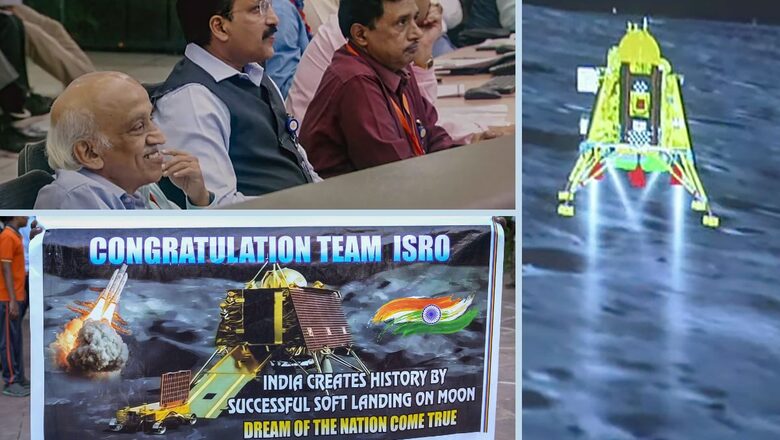
views
“Vision is the art of seeing what is invisible to others.”
There was never a dearth of talent, hard work and energy in Indians. The support through various strategic policies of the committed credible leadership of the Narendra Modi government made a difference. It is not an exaggeration to say that the nation has attained staggering progress in the last nine years which was more than what was achieved in all the years prior to 2014 put together. The vision of Prime Minister Modi has paved the way for the realisation of Atmanirbhar Bharat.
India is now
- Second largest manufacturer of mobile phones
- Third biggest manufacturer of automobiles
- Pharmacy of the world
- The only country to land on the south pole of the moon
A sneak peek shows great positive change in manufacturing in various fields in India in 9 years.
‘Made in India’ – The mark is everywhere, from mobile to moon
There are more than 90,000 startups, including 110 unicorns, in which young Indians are playing a big part. Success in various sectors is inspiring and unbelievable.
More than 97 per cent of the smartphones sold in India are now being produced locally. India is now the second-largest mobile phone manufacturer in the world. Mobile production in India has increased from 5.8 crore units valued at Rs 18,900 crore in 2014-15 to 31 crore units valued at Rs 2,75,000 crore in 2022-2023. The export of mobile phones touched a record high of 90,000 crores in 2022-2023 and is expected to cross Rs 1.2 lakh crores. In May, iPhone exports reached a record Rs 10,000 crore, pushing the total mobile shipments from the country to Rs 12,000 crores. The top five global destinations India currently exports mobile phones to are the UAE, the US, the Netherlands, the UK and Italy. The mobile phone industry is expected to cross Rs 3.3 lakh crores in manufacturing output. The government aims to increase electronics manufacturing capability to Rs 24 lakh crores by 2025-26, which will also help create over 10 lakh jobs.
India has transformed from being a predominant importer of defence equipment to an exporter. There is a strategic shift towards self-reliance and indigenous manufacturing capabilities. India’s defence exports rose by over 23 times from Rs 686 crore in 2013-2014 to an all-time high of around Rs 16,000 crore in 2022-23. India has set itself an ambitious defence export target of Rs 35,000 crore by 2024-25. The expenditure on defence procurement from foreign sources has reduced from 46 per cent of the overall expenditure in 2018-19 to 36.7 per cent as of December 2022.
India is now successfully able to manufacture artillery guns, Brahmos Missiles, PINAKA rockets and launchers, radars, simulators, armoured vehicles and aircraft such as the Dornier-228, Tejas, etc. In February 2021, the defence ministry inked a Rs 48,000 crore deal with Hindustan Aeronautics Ltd for procurement of 83 Tejas MK-1A jets for the IAF. The 45,000-tonne warship INS Vikrant was the first and the largest ever to be built in the country, indigenously, at a cost of Rs 20,000 crore. The warship has been built using indigenous equipment and machinery supplied by India’s major industrial houses as well as more than 100 MSMEs. Cochin shipyard is currently constructing eight anti-submarine warfare shallow watercraft and it has also bagged an order for the construction of six next-generation missile Vessels for the Indian Navy.
India is regarded as the ‘pharmacy of the world’ and ranked third-largest in pharma production by volume. The uniqueness of the Indian pharmaceutical industry is affordable price and high quality. India has the most number of United States Food and Drug Administration (USFDA) approved units (741 as of August 2021). India is the largest provider of generics globally, accounting for over 20 per cent of the global generic supply by volume. The pharmaceutical industry in India is currently valued at Rs 4.13 lakh crores. India’s pharmaceutical exports have maintained their upward trend, reaching roughly Rs 2,08,231 crore, for the financial year 2022-23. The pharmaceutical industry in India is expected to reach Rs 5.38 lakh crores by 2024 and Rs 10.7 lakh crores by 2030.
India is the world leader in supplying vaccines like DPT, BCG, and Measles accounting for 60 per cent of global vaccine demand, and is a leading supplier of DPT, BCG and Measles vaccines. 70 per cent of WHO’s vaccines (as per the essential Immunization schedule) are sourced from India.
Currently, India is the third-largest automotive market in the world. India aims to double its auto industry size to Rs 15 lakh crore by the end of 2024. Between April 2021 and March 2022, the Indian automobile industry produced a staggering total of 22,933,230 vehicles and has achieved a turnover of Rs 8.7 lakh crores. India’s automobile sector currently accounts for 7.5 per cent of the country’s total GDP, creating over 32 million job opportunities in the process. With an impressive expected CAGR of 11.3 per cent from 2020 to 2027, the Indian auto industry is only expected to continue its upward trajectory.
The exports from the toy industry in the last nine years have significantly increased, from Rs 305 crores million in 2013-14 to Rs 1266 crores in 2022-23, registering a 316 per cent growth during this time period.
The latest success of Chandrayaan-3 proved the mettle of India. India is the only country to do a soft landing on the south pole of the moon. India is among the top 4 countries to land on the moon and develop anti-satellite technology. From January 2018 to November 2022, ISRO successfully launched 177 foreign satellites from 19 countries — Australia, Brazil, Canada, Colombia, Finland, France, Israel, Italy, Japan, Lithuania, Luxembourg, Malaysia, Netherlands, Republic of Korea, Singapore, Spain, Switzerland, United Kingdom, the United States and earned Rs 1830 crores.
The vision behind Atmanirbhar Bharat
PM Modi-led Central government took several measures in the last five years to make India self-reliant. Production Linked Incentive (PLI) launched in 2020 is pivotal in strengthening India’s manufacturing sector by incentivising domestic and foreign investments and paving the way for producing global champions in the manufacturing industry.
Through targeted incentives and support to sectors like electronics, automobiles, pharmaceuticals, MedTech, food, telecom, solar, textiles, and drones, the scheme encourages companies to invest in areas where India has the potential. The government has allocated Rs 1.97 lakh crore for the PLI schemes for the 14 sectors. The main goal is to boost production in India. The government has decided to extend the Rs 25938 crore PLI scheme to the automobile industry by one year till 2026-27.
Tax reforms brought by the Modi government in 2019 gave a big push to industries in India. India’s corporate tax is now among the lowest globally. In September 2019, India decreased the corporate tax from 30 per cent to 22 per cent for existing companies and from 25 per cent to 15 per cent for new companies.
Modi government has focused on the development of 11 economic corridors across the country. Special economic zones were created. There was significant improvement in logistics and transport.
Reforms specific to each sector were formulated. Some being
- Exemption of import duties on certain parts like camera lens.
- Concessional duties on lithium-ion cells for batteries.
- Boosting TV production by reducing customs duty to 2.5 per cent on parts of open cells of TV panels.
- Bulk Drug Park initiative to support the Indian pharma industry.
- Strategic schemes like FAME, PLI, tariffs, tax incentives, etc. for the penetration of electric vehicles.
- Revision of the import duty to 70 per cent on toys which has given a boost to local manufacturing. The ‘Quality Control Order’ was also introduced to regulate the quality of toys in accordance with the Bureau of Indian Standards. The National Action Plan for Toys, launched in 2020, brought 15 ministries together providing momentum to the toy manufacturers.
All these measures have changed the picture of India. “INS Vikrant is the pride of every Indian. If challenges are large, and obstacles are many, then the answer is INS Vikrant,” Prime Minister Modi had said. Various obstacles were strategically tackled and here we see a New India on the way to becoming ‘Vishwa Guru’ – a global leader. Now the motto is “Make In India – Make for the World”.
Dr Vinusha Reddy is Delegate of BRICS Political Parties plus dialogue summit, Official Spokesperson, In charge of policy & Research, Mahila Morcha BJP Andhra Pradesh. Views expressed in the above piece are personal and solely that of the author. They do not necessarily reflect News18’s views.




















Comments
0 comment